Equity markets set convincing new highs | Luminor
Equity markets set convincing new highs

- Major equity markets on the rise
- The U.S. economy is still strong
- Bank of Japan ends negative rates era
In March, equity markets have surged to new highs, with the S&P 500 showing its strongest start since 2019, supported by notable performance from tech giants. Additionally, other developed market equities have continued to do well this year as the likelihood of recession recedes. However, alongside this optimism, caution is warranted in the short term due to potential market volatility and some signs of economic slowdown. Meanwhile, central banks, including the Federal Reserve (FED), European Central Bank (ECB), and Bank of Japan (BoJ), have made policy decisions that are shaping the global economic outlook. Their actions have been a major focus in global markets for the past few years, and it seems they will remain so for some time.
As a result, developed markets’ stock index MSCI World has risen by 2.72%, while emerging markets stocks’ index MSCI Emerging Markets has surged by 2.43%. During the same period yields on bonds have decreased slightly, with 10‑year US Treasury bond yields declining to 4.2% (compared to 4.25% 1 month ago) and German 10‑year bond yields decreasing to 2.29%, down from 2,41% a month ago.
Equity markets set new highs
The S&P 500 has had its strongest start since 2019, surging by approximately 10% and marking another record high for the year. The mega‑cap tech stocks such as Microsoft, Apple, Alphabet, Meta Platforms, Amazon and Nvidia have kept the lead in the rising market by gaining around 17% year‑to‑date, driven by excitement around artificial intelligence (AI) and robust earnings’ trends. Traditionally, a strong early performance often signals well for the market's prospects throughout the remainder of the year. However, this promising beginning is sparking some caution for the short term. This caution stems from the fact that much of the positive news may already be reflected in the current market prices, making it sensitive to any unexpected downturns in earnings or the economy.. Additionally, one must be reminded that the equity market typically experiences three to four drops of 5% or more each year, and the last significant pullback in the S&P 500 index occurred in October 2023, only, as many investors have been evidently confident in the future prospects.
The U.S. economy is still doing well
The U.S. economy has seen two consecutive quarters of robust GDP growth exceeding 3%, (see Chart) leading to diminishing recession concerns. This stability is supported by strong consumer fundamentals, including record‑high household net worth and a growth in personal incomes. However, there are signs indicating a potential slowdown in growth. For instance, there has been a significant increase in credit card debt, record‑high borrowing rates, and a rise in credit card delinquencies. Additionally, both consumer and business confidence have slightly decreased since the beginning of the year. Despite these warnings, the labor market remains resilient, with strong job growth in the first months of the year. The inflation has decreased throughout 2023, but there has been a recent uptick in the past few months, which may prompt policymakers to remain cautious in their interest rate cut considerations. However, a sustained reacceleration in inflation seems unlikely due to decreasing global commodity prices, normalized supply chains, and consumer resistance to price hikes. Overall, while inflation may experience some fluctuations, it is unlikely to significantly alter the Fed's inflation forecasts to reach 2%.

Updates from Central banks
As expected, the FED closed out its March meeting by holding the federal funds rate at its current target range of 5.25%‑5.50%. This decision marks the fifth consecutive FED meeting where the central bank decided to keep interest rates at their current levels. As indicated in the updated Summary of Economic Projections (SEP) and “dot plot,” rate cuts remain on the horizon, with the Fed forecasting three 0,25% cuts occurring by this year’s end. No specifics were given as to when cuts would begin, with Chair Powell reiterating that all monetary policy decisions are made “meeting by meeting.” Markets reacted favorably to the Fed’s rate cut projections, with the S&P 500 moving above 5,200 for the first time.
The European Central Bank (ECB) and the Bank of Japan (BoJ) also held policy meetings last month. The ECB held rates unchanged, but its chief Christine Lagarde said discussions over easing policy have begun and plenty of relevant information would become available by June. Meanwhile, the BoJ made a notable move by raising interest rates for the first time in 17 years, from ‑0.1% to 0.1%, ending the world's only negative interest‑rate regime. BoJ policymakers reiterated in a post‑meeting press conference that a gradual approach will be taken to any further rate hikes, signaling that financial conditions will likely remain accommodative in the near term. Despite this significant decision, the overall market reaction was fairly muted, as markets had largely anticipated a rate hike.
Market view
Overall, central banks are expected to continue playing a key role in shaping financial markets in the near future, especially with decreasing inflation and the potential for interest rate cuts later this year. While the economy appears to be heading towards a soft landing, it is premature to declare mission accomplished. With a lot of good news priced in the current financial markets valuations, the investment team remains cautious of the potential volatility ahead.
Warnings:
- This Marketing Communication is not considered investment research and has not been prepared in accordance with standards applicable to independent investment research.
- This Marketing Communication does not limit or prohibit the bank or any of its employees from dealing prior to its dissemination.
Origin of the Marketing Communication
This Marketing Communication originates from Portfolio Management unit (hereinafter referred to as PMU) – a division of Luminor Bank AS (reg. No 11315936, with registered address at Liivalaia 45, 10145, Tallinn, Republic of Estonia, hereinafter - Luminor). PMU is involved in the provision of discretionary portfolio management services to Luminor clients.
Supervisory authority
As a credit institution Luminor is subject to supervision by the Estonian financial supervision and resolution authority (Finantsinspektsioon). Additionally, Luminor is subject to supervision by the European Central Bank (ECB), which undertakes such supervision within the Single Supervisory Mechanism (SSM), which consists of the ECB and the national responsible authorities (Council Regulation (EU) No 1024/2013 - SSM Regulation). Unless set out herein explicitly otherwise, references to legal norms refer to norms enacted by the Republic of Estonia.
Content and source of the publication
This Marketing Communication has been prepared by PMU for information purposes. Luminor will not consider recipients of this Communication as its clients and accepts no liability for use by them of the contents, which may not be suitable for their personal use.
Opinions of PMU may deviate from recommendations or opinions presented by the Luminor Markets unit. The reason may typically be the result of differing investment horizons, using specific methodologies, taking into consideration personal circumstances, applying a specific risk assessment, portfolio considerations or other factors. Opinions, price targets and calculations are based on one or more methods of valuation, for instance cash flow analysis, use of multiples, behavioural technical analyses of underlying market movements in combination with considerations of the market situation, interest rate forecasts, currency forecasts and investment horizon.
Luminor uses public sources that it believes to be reliable. However, Luminor has not performed independent verification. Luminor makes no guarantee, representation or warranty as to their accuracy or completeness. All investments entail a risk and may result in both profits and losses.
This Marketing Communication constitutes neither a solicitation of an offer nor a prospectus in the sense of applicable laws. An investment decision in respect of a financial instrument, a financial product or an investment (all hereinafter “product”) must be made on the basis of an approved, published prospectus or the complete documentation for such a product in question and not on the basis of this document. Neither this document nor any of its components shall form the basis for any kind of contract or commitment whatsoever. This document is not a substitute for the necessary advice on the purchase or sale of a financial instrument or a financial product.
No Advice
This Marketing Communication has been prepared by Luminor PMU as general information and shall not be construed as the sole basis for an investment decision. It is not intended as a personal recommendation of particular financial instruments or strategies. Luminor accepts no liability for the use of the Marketing Communication content by its recipients.
If this Marketing Communication contains recommendations, those recommendations shall not be considered as an objective or independent explanation of the matters discussed herein. This document does not constitute personal investment advice or take into account the individual financial circumstances or objectives of the persons who receive it. The securities or other financial instruments discussed herein may not be suitable for all investors. The investor bears all risk of loss in connection with an investment. Luminor recommends that investors independently evaluate each issuer, security or instrument discussed herein and consult any independent advisors if they believe it necessary.
The information contained in this document also does not constitute advice on the tax consequences of making any particular investment decision. The estimates of costs and charges related to specific investment products are not provided therein. Each investor shall make his/her own appraisal of the tax and other financial advantages and disadvantages of his/her investment.
Risk information
The risk of investing in certain financial instruments, including those mentioned in this document, is generally high, as their market value is exposed to many different factors. The value of and income from any investment may fluctuate from day to day as a result of changes in relevant economic markets (including changes in market liquidity). The information herein is not intended to predict actual results, which may differ substantially from those reflected. Past performance is not necessarily indicative of future results. When investing in individual financial instruments the investor may lose all or part of their investments.
Important disclosures of risks regarding investment products and investment services are available here.
Conflicts of interest
To avoid occurrence of potential conflicts of interest as well as to manage personal account dealing and / or insider trading, the employees of Luminor are subject to the internal rules on sound ethical conduct, management of inside information, and handling of unpublished research material and personal account dealing. The internal rules have been prepared in accordance with applicable legislation and relevant industry standards. Luminor’s Remuneration Policy establishes no link between revenues from capital markets activity and remuneration of individual employees.
The availability of this Marketing Communication is not associated with the amount of executed transactions or volume thereof.
This material has been prepared following the Luminor Conflict of Interest Policy, which may be viewed here.
Distribution
This Marketing Communication may not be transmitted to, or distributed within, the United States of America or Canada or their respective territories or possessions, nor may it be distributed to any U.S. person or any person resident in Canada. The document may not be duplicated, reproduced and(or) distributed without Luminor’s prior written consent.
